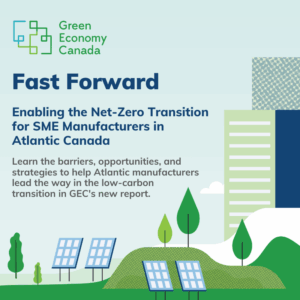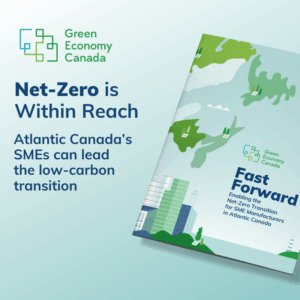Unlocking Net Zero Pathways for SMEs
Projects Sponsor
Faced with the challenge of decarbonizing Atlantic Canada’s manufacturing sector, Green Economy Canada guided four small and medium-sized enterprises through net-zero technical studies, mapping out practical pathways for emissions reductions. From energy efficiency and solar potential to grid decarbonization and purchasing agreements, the project identified opportunities to cut emissions by up to 91%, saving participants over $1M annually and revealing the systemic supports needed to mobilize action and unlock pathways to net zero across the region. Small enterprises, big impact.
Small and medium-sized enterprises (SMEs) contribute approximately 41% of Canada’s GHG emissions and make up 98% of the business landscape in Atlantic Canada. Despite their critical role in the economy and the net-zero transition, SME manufacturers often lack the technical capacity, resources, and policy supports necessary to facilitate meaningful climate action. Many operate in energy-intensive industries, face high energy and transportation costs, and have limited access to capital and service providers.
Green Economy Canada set out to bridge the gap between intention and action by combining technical feasibility, economic rationale, and systems-level insight. Their Unlocking Net Zero Pathways for SMEs project was designed to allow SMEs to join in the transition to a net-zero economy
 Green Economy Canada, launched the project to address systemic barriers, accelerate decarbonization and future-proof business for SME manufacturers in the region. The project followed a structured, multi-phase approach aimed at generating deep insights into the decarbonization potential and needs of SME manufacturers in Atlantic Canada. A combination of technical analysis, ecosystem mapping, and stakeholder engagement was used to id entify net-zero pathways for SME manufacturers by completing technical studies (GHG inventories and ASHRAE Level II energy audits) at four facilities, one in each Atlantic province.
Green Economy Canada, launched the project to address systemic barriers, accelerate decarbonization and future-proof business for SME manufacturers in the region. The project followed a structured, multi-phase approach aimed at generating deep insights into the decarbonization potential and needs of SME manufacturers in Atlantic Canada. A combination of technical analysis, ecosystem mapping, and stakeholder engagement was used to id entify net-zero pathways for SME manufacturers by completing technical studies (GHG inventories and ASHRAE Level II energy audits) at four facilities, one in each Atlantic province.
A landscape review held prior to the launching of the project had given Green Economy Canada team insights into the emissions profile of SME manufacturers, the specific regional challenges these enterprises face, and their existing decarbonization efforts. Key research included a review of national emissions data showing SMEs contribute 41% of Canada’s total GHGs—underscoring their importance in reaching net-zero targets. Regional economic analysis revealed that manufacturing comprises 7% of Atlantic Canada’s GDP and employs over 81,000 people—predominantly in SMEs concentrated in rural communities. Ultimately the success of the green economy relies on finding ways for these SMEs and all those workers to be part of it.
A comprehensive review of the policy landscape was undertaken in order to form a better understanding of the accessibility and relevance of existing decarbonization supports for SMEs at both the provincial and federal level. Part of this effort was a review of 152 federal and regional decarbonization programs (2016–2024), including incentives, tax credits, regulations, and support tools. An evaluation of service provider capacity—conducted by interviewing energy consultants, engineers, and contractors across Atlantic Canada—was used to assess their ability to support SME decarbonization.
Existing climate policy reviews revealed that most federal and provincial incentive programs were not tailored to the needs of SMEs, often requiring large capital investments or lengthy applications beyond the capacity of smaller businesses.
Other barriers faced by SMEs—as reported in prior studies—include a lack of internal expertise, time, and capital, as well as difficulty accessing service providers.
It became clear that while SMEs were increasingly aware of the need to act on climate, they lacked tailored supports and clear pathways to do so. The Green Economy Canada team’s research also highlighted a gap in integrated, region-specific approaches that aligned technical, financial, and policy levers. These findings shaped the project design—prioritizing practical, business-aligned decarbonization strategies that accounted for Atlantic Canada’s unique energy systems, infrastructure limitations, and economic structure.
Participant Recruitment began in Fall of 2023. An open call went out to SME manufacturers across Atlantic Canada with less than 500 employees and executive buy-in. From these, four SMEs—one from each province—were selected, representing the diverse sectors to food, plastics, safety equipment, and trailer manufacturing.
Technical Studies of these participating SMEs, GHG inventories and energy audits followed in late 2023 and early 2024. ASHRAE Level II audits and Energy Management Information System (EMIS) assessments were conducted at each site. From these GHG baselines: Scope 1 and 2 emissions inventories developed using the GHG Protocol, with 2022 as the base year.
This allowed the team to develop a customized net-zero pathway for each SME. These maps to green land prioritized energy efficiency and solar measures, cost/ROI analysis, and implementation guidance.
Ensuring that these energy audit results and the resulting net-zero plans were easy for SMEs and non-engineers to understand was key to making the project a success. The team learned that there are a lot of assumptions that are structured into how a standard energy audit determines what measures are ultimately recommended. These assumptions—which led to a few difficult conversations with their technical partner—lean heavily into the status quo but challenging them did prove that SME manufacturers are able to reach net zero if the ecosystem shifts to support them.
 As it is, the incentive landscape is currently a challenge in itself—it was difficult for the trained team to decipher what was active and applicable to the participants and their pathways—the busy operator of an SME might well not engage with the process for long.
As it is, the incentive landscape is currently a challenge in itself—it was difficult for the trained team to decipher what was active and applicable to the participants and their pathways—the busy operator of an SME might well not engage with the process for long.
But from energy efficiency to solar potential, and to grid decarbonization to purchasing agreements, the project identified opportunities to cut emissions by up to 91%, saving participants over $1M annually and revealing the systemic supports needed to mobilize net-zero action across the region. A final report and case studies were published to inform broader policy and program design across Atlantic Canada. Cross-cutting recommendations addressing SME needs included funding accessibility, workforce development, and the importance of grid decarbonization.
Throughout the project, Green Economy Canada served as the lead intermediary, coordinating technical partners (CBCL Ltd. and Pembina Institute), managing relationships with SMEs and service providers, and translating findings into actionable guidance. The project was designed to be replicable and scalable, offering a template for engaging SMEs in other regions.
By producing real-world, site-specific pathways and highlighting systemic levers for change, the project built a foundation for scalable SME engagement in Canada’s climate goals—while also demonstrating tangible financial benefits for early movers. Helping small and medium-sized enterprises reach net-zero is sure to have a big impact.













